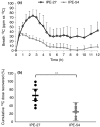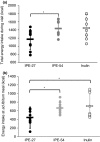Randomised clinical study: inulin short-chain fatty acid esters for targeted delivery of short-chain fatty acids to the human colon
- PMID: 27464984
- PMCID: PMC5026196
- DOI: 10.1111/apt.13749
Randomised clinical study: inulin short-chain fatty acid esters for targeted delivery of short-chain fatty acids to the human colon
Abstract
Background: Short-chain fatty acids (SCFA) produced through fermentation of nondigestible carbohydrates by the gut microbiota are associated with positive metabolic effects. However, well-controlled trials are limited in humans.
Aims: To develop a methodology to deliver SCFA directly to the colon, and to optimise colonic propionate delivery in humans, to determine its role in appetite regulation and food intake.
Methods: Inulin SCFA esters were developed and tested as site-specific delivery vehicles for SCFA to the proximal colon. Inulin propionate esters containing 0-61 wt% (IPE-0-IPE-61) propionate were assessed in vitro using batch faecal fermentations. In a randomised, controlled, crossover study, with inulin as control, ad libitum food intake (kcal) was compared after 7 days on IPE-27 or IPE-54 (10 g/day all treatments). Propionate release was determined using (13) C-labelled IPE variants.
Results: In vitro, IPE-27-IPE-54 wt% propionate resulted in a sevenfold increase in propionate production compared with inulin (P < 0.05). In vivo, IPE-27 led to greater (13) C recovery in breath CO2 than IPE-54 (64.9 vs. 24.9%, P = 0.001). IPE-27 also led to a reduction in energy intake during the ad libitum test meal compared with both inulin (439.5 vs. 703.9 kcal, P = 0.025) and IPE-54 (439.5 vs. 659.3 kcal, P = 0.025), whereas IPE-54 was not significantly different from inulin control.
Conclusions: IPE-27 significantly reduced food intake suggesting colonic propionate plays a role in appetite regulation. Inulin short-chain fatty acid esters provide a novel tool for probing the diet-gut microbiome-host metabolism axis in humans.
© 2016 The Authors. Alimentary Pharmacology & Therapeutics Published by John Wiley & Sons Ltd.
Figures



Similar articles
-
Effects of Inulin Propionate Ester Incorporated into Palatable Food Products on Appetite and Resting Energy Expenditure: A Randomised Crossover Study.Nutrients. 2019 Apr 16;11(4):861. doi: 10.3390/nu11040861. Nutrients. 2019. PMID: 30995824 Free PMC article. Clinical Trial.
-
The effects of dietary supplementation with inulin and inulin-propionate ester on hepatic steatosis in adults with non-alcoholic fatty liver disease.Diabetes Obes Metab. 2019 Feb;21(2):372-376. doi: 10.1111/dom.13500. Epub 2018 Sep 16. Diabetes Obes Metab. 2019. PMID: 30098126 Free PMC article. Clinical Trial.
-
Increased colonic propionate reduces anticipatory reward responses in the human striatum to high-energy foods.Am J Clin Nutr. 2016 Jul;104(1):5-14. doi: 10.3945/ajcn.115.126706. Epub 2016 May 11. Am J Clin Nutr. 2016. PMID: 27169834 Free PMC article. Clinical Trial.
-
Impact of the source of fermentable carbohydrate on SCFA production by human gut microbiota in vitro - a systematic scoping review and secondary analysis.Crit Rev Food Sci Nutr. 2021;61(22):3892-3903. doi: 10.1080/10408398.2020.1809991. Epub 2020 Aug 31. Crit Rev Food Sci Nutr. 2021. PMID: 32865002
-
Do SCFA have a role in appetite regulation?Proc Nutr Soc. 2011 Feb;70(1):119-28. doi: 10.1017/S0029665110004039. Proc Nutr Soc. 2011. PMID: 21266094 Review.
Cited by
-
Efficiency of Resistant Starch and Dextrins as Prebiotics: A Review of the Existing Evidence and Clinical Trials.Nutrients. 2021 Oct 26;13(11):3808. doi: 10.3390/nu13113808. Nutrients. 2021. PMID: 34836063 Free PMC article. Review.
-
Effects of Inulin Propionate Ester Incorporated into Palatable Food Products on Appetite and Resting Energy Expenditure: A Randomised Crossover Study.Nutrients. 2019 Apr 16;11(4):861. doi: 10.3390/nu11040861. Nutrients. 2019. PMID: 30995824 Free PMC article. Clinical Trial.
-
Engineering Strategies to Modulate the Gut Microbiome and Immune System.J Immunol. 2024 Jan 15;212(2):208-215. doi: 10.4049/jimmunol.2300480. J Immunol. 2024. PMID: 38166246 Free PMC article. Review.
-
Gut Microbiota Interaction with the Central Nervous System throughout Life.J Clin Med. 2021 Mar 21;10(6):1299. doi: 10.3390/jcm10061299. J Clin Med. 2021. PMID: 33801153 Free PMC article. Review.
-
Impact of Glycosidic Bond Configuration on Short Chain Fatty Acid Production from Model Fermentable Carbohydrates by the Human Gut Microbiota.Nutrients. 2017 Jan 1;9(1):26. doi: 10.3390/nu9010026. Nutrients. 2017. PMID: 28045429 Free PMC article.
References
-
- De Vadder F, Kovatcheva‐Datchary P, Goncalves D, et al Microbiota‐generated metabolites promote metabolic benefits via gut‐brain neural circuits. Cell 2014; 156: 84–96. - PubMed
-
- Trompette A, Gollwitzer ES, Yadava K, et al Gut microbiota metabolism of dietary fiber influences allergic airway disease and hematopoiesis. Nat Med 2014; 20: 159–66. - PubMed
Publication types
MeSH terms
Substances
Grants and funding
- BB/H532075/1/BB_/Biotechnology and Biological Sciences Research Council/United Kingdom
- BB/H532091/1/BB_/Biotechnology and Biological Sciences Research Council/United Kingdom
- BB/L004259/1/BB_/Biotechnology and Biological Sciences Research Council/United Kingdom
- BB/H005072/1/BB_/Biotechnology and Biological Sciences Research Council/United Kingdom
- BB/H004815/1/BB_/Biotechnology and Biological Sciences Research Council/United Kingdom
